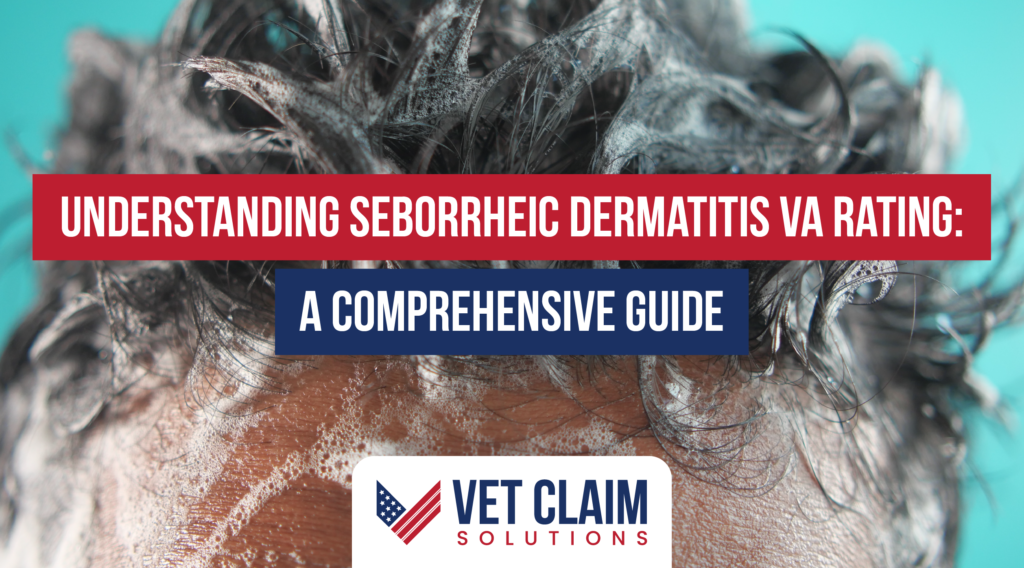Understanding Seborrheic Dermatitis: More Than Just “Dandruff”
There’s a misconception that Seborrheic Dermatitis is simply “bad dandruff”, but this couldn’t be further from the truth. While it commonly affects the scalp, causing those telltale flakes, it can show up on the face, chest, and back too. Imagine dealing with red, itchy, scaly patches in these areas, constantly worrying about appearance and discomfort – that’s the reality for many veterans seeking a VA disability rating. It can make it difficult to gainful employment and impact your social life.
Causes and Triggers
The exact causes? We’re still unraveling those. However, we know factors like genetics, an overgrowth of yeast on the skin (Malassezia), and even a person’s immune system response all seem to play a role. For veterans, it’s important to think back to experiences during service. Harsh weather, extreme stress – these can all contribute to flare-ups and may help establish that crucial service connection for VA benefits.

How Seborrheic Dermatitis VA Rating Works: Breaking Down the System
Let’s get down to the nuts and bolts of Seborrheic Dermatitis VA Rating. It boils down to something called the General Rating Formula for Skin Conditions, and there are a couple of important things the VA will assess:

Severity and Coverage:
The VA considers how much of your body is affected – whether those red, itchy patches cover a small area or a significant portion of your skin. The location of your symptoms plays a role as well. Remember that photographic evidence that shows how much of your body is affected can really help your claim.

Treatment Needs:
What kind of treatments have you been prescribed, and for how long? Have topical creams been enough, or have you needed oral medications or even light therapy? The VA will assess how your prescribed treatment impacts your daily life.
To paint a clearer picture, here’s what the VA rating scale often looks like (always keep in mind that individual cases can vary, making a strong case with your medical evidence is key.)
| VA Rating for Seborrheic Dermatitis | Common Criteria |
|---|---|
| 60% | The most severe level, generally meaning seborrheic dermatitis affects over 40% of your body or needs continuous, aggressive treatment like systemic medications. This level of severity may make it difficult to maintain gainful employment. |
| 30% | Symptoms affecting 20%-40% of your body or requiring systemic treatment but not constantly for the whole year. |
| 10% | This typically means less than 20% of your body is affected by mild-to-moderate seborrheic dermatitis and needs some periods of oral or light therapy. |
| 0% | Typically indicates that the condition is mild, affects a minimal area, and responds well to simple topical treatments. |
Service Connecting Seborrheic Dermatitis: Creating a Strong Claim
Many veterans I’ve spoken to struggle with connecting their skin conditions to their service, especially if symptoms surfaced years after leaving active duty. However, many cases of Seborrheic Dermatitis can be successfully linked to military service. One way to do this is through what’s called “secondary service connection”. Let me explain.
Secondary Service Connection
This basically means showing that your Seborrheic Dermatitis is caused or aggravated by a different condition that IS already service-connected. It could be another skin condition (think eczema or psoriasis), mental health issues like PTSD or anxiety, or even conditions like Parkinson’s Disease. This connection is an important part of filing a VA disability claim.
Gathering Your Evidence

It’s all about presenting a clear, compelling narrative backed by solid evidence. This will help you receive an accurate disability rating.
- Medical Records: Your in-service medical records, VA medical records, and even private treatment records all form the foundation of your claim. They demonstrate the history of your Seborrheic Dermatitis.
- Nexus Letter: This is crucial – a statement from a qualified medical professional connecting your seborrheic dermatitis to your service or a service-connected condition. The medical professional can discuss any presumptive conditions that may apply to you as well.
- Personal Statement: Your personal statement is where you become the expert of your own experience. Detail how your symptoms affect your life, including work, social situations, and daily activities.
Navigating Challenges: Addressing Common Roadblocks
If filing a VA disability claim for something as seemingly “common” as seborrheic dermatitis was easy, everyone would do it, right? Let’s face it, things aren’t always that simple. Here’s the truth – denials happen. But knowing why claims are often denied is half the battle. By being aware of these pitfalls, we can be proactive and avoid falling into these traps.

Lack of In-Service Documentation
You know what they say – if it’s not in your records, it didn’t happen (at least as far as the VA is concerned). Many veterans didn’t report their skin issues during service because let’s be real – skin conditions can seem small in the grand scheme of things when you’re in a demanding military environment. This is a major hurdle to receiving disability compensation.

Difficulty Proving the Nexus
It’s not always easy drawing a clear line from your current seborrheic dermatitis back to your service, especially if it cropped up years later. Proving this link is where many veterans get tripped up, which is where a strong nexus letter from a medical professional can be incredibly valuable. Be sure to get help from a qualified medical professional who understands veterans disability benefits and common skin conditions.

Don’t Navigate the VA Alone: Getting Expert Help
I’ll be upfront with you – even armed with information, navigating this system solo is TOUGH. I’ve been there. Thankfully, there are resources out there specifically for veterans dealing with conditions like Seborrheic Dermatitis. You don’t have to do this alone. Consider seeking help from veterans service organizations, qualified VA disability attorneys or claim agents – these professionals understand the intricacies of the VA system. This can dramatically increase your odds of getting the disability rating and support you deserve.
Conclusion
For any veteran going through the process of obtaining a Seborrheic Dermatitis VA disability rating, remember that you’re not just dealing with an itch – you’re dealing with a legitimate medical condition that deserves recognition. While the journey might feel overwhelming, arming yourself with knowledge, being persistent, and seeking out support can truly make all the difference. Keep in mind the experiences you’ve had and how those connect with your Seborrheic Dermatitis now because they’re key in creating a successful claim. Your health and well-being matter – fight for the benefits you’ve earned.
FAQs About Seborrheic Dermatitis VA Rating
1. What is the VA rating for dermatitis?
The VA rating for seborrheic dermatitis (a type of dermatitis) ranges from 0% to 60%, with 10% and 30% as intermediate ratings. The rating is based on severity factors such as body coverage, required treatments, and impact on daily functioning, and uses the same rating formula as regular dermatitis under Diagnostic Code 7806. Be sure to keep track of all your medical records as they relate to your symptoms.
2. What conditions are related to seborrheic dermatitis?
Many conditions can worsen or trigger seborrheic dermatitis in veterans, and claiming these as secondary to your service-connected conditions could strengthen your overall claim. Some related conditions often seen in veterans with Seborrheic Dermatitis include other skin issues (like psoriasis and eczema), mental health challenges such as PTSD and anxiety, neurological conditions (including Parkinson’s disease) , hormonal imbalances, and autoimmune disorders. Remember, providing evidence for a strong secondary service connection significantly boosts your claim for benefits, as the VA then recognizes your skin condition as being directly linked to your service.
3. Is seborrheic keratosis a VA disability?

Although they sound similar, seborrheic keratosis is NOT the same thing as seborrheic dermatitis. It is important to note that Seborrheic keratosis is usually considered a harmless condition, while Seborrheic dermatitis can be severe, painful, and can even lead to secondary complications from infections and skin damage due to scratching. The good news is the VA DOES provide disability benefits for any condition (including benign growths like seborrheic keratosis) as long as it’s a result of a service-connected injury or event AND requires treatment. If you are diagnosed with a skin growth like seborrheic keratosis that resulted from a service-connected injury (perhaps burns, infections during treatment, or reactions to service-required medications), document everything. Gather those medical records and submit your claim, demonstrating the link between the condition and your service.
4. Can you get VA disability for dandruff?
Yes, but there’s a catch. The VA recognizes severe cases of dandruff, especially when they’re actually seborrheic dermatitis. So while you won’t see a “dandruff” rating in their system, it’s vital to clearly describe ALL your symptoms. Highlight any redness, inflammation, itching beyond typical dandruff, especially if it affects your face or body too. Seek a formal diagnosis for anything beyond mild dandruff as early as possible. These records will be your evidence in establishing a claim.
Conclusion
Securing a fair Seborrheic Dermatitis VA Rating involves understanding the system’s nuances, the importance of strong evidence, and potential pitfalls. It’s a process many veterans understandably find overwhelming – you don’t need to navigate it alone. Seek out help and remember, advocating for yourself is CRUCIAL. Focus on what’s important here – your health and peace of mind, and know that the right support and a compelling case significantly improve your chances of getting the benefits you’ve rightfully earned.


